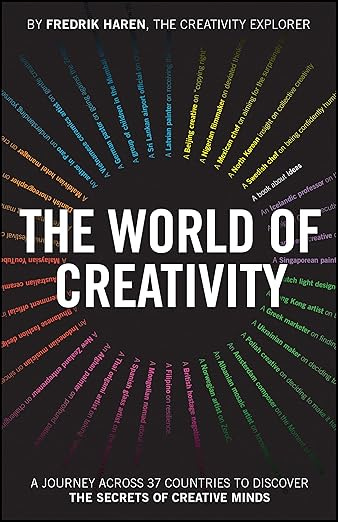High above a quiet island outside Stockholm, Fredrik Haren, a creativity explorer, sits inside a geometric bubble of glass and sky, surrounded by 360 degrees of sea. It’s his office, but it’s also a laboratory for ideas and reflection.
Over the past 25 years, he’s interviewed thousands of creative minds in 75 countries, from painters in Riga to ministers in Bhutan, from Korean guides to designers in Bangkok.
But the story of how he came to call himself a Creativity Explorer began not with a grand idea, but with a beautiful mistake.
His eight-year-old son once told a class full of students that his dad was a “creativity explorer.” He meant to say “expert” but Fredrik didn’t correct him.
“An expert gives answers,” Fredrik told me. “An explorer asks questions.”
Insight #1: Creativity Is What Makes Us Human
Fredrik’s own definition of creativity shifts depending on who he speaks with. To one painter in Latvia, creativity was “receiving the mystery.” To a former minister in Bhutan, it was “an inward journey of understanding yourself.”
But Fredrik’s current definition is simple:
“Creativity is what makes us human.”
It’s not confined to artists or innovators. It’s the universal process of connecting ideas, emotions, and experiences into something new. Whether you’re a coder, a cook, or a CEO, your ability to imagine and make meaning is what sets you apart from machines.
That’s why, as AI accelerates and automation takes over more tasks, our true edge will come from imagination.
And imagination starts with curiosity.
Insight #2: Inspiration In, Creation Out
Fredrik shared a story about his father, a music teacher who could play ten instruments. When parents asked how to make their children musicians, his father would reply:
“You can teach anyone to play. But to make them a musician, you have to inspire them.”
That distinction changed the way Fredrik views creativity. Techniques and frameworks can help, but inspiration i.e. what we breathe in, is what feeds the creative soul.
Still, as he points out, inspiration alone isn’t enough.
“Inspiration means to breathe in. Creativity means to breathe out.”
Too many of us get stuck inhaling, scrolling, consuming, learning, attending webinars, and never exhaling.
Half the year, he travels, meeting people and soaking in ideas. The other half, he retreats to his island dome, disconnecting from the noise and transforming inspiration into books, talks, and reflection.
That cycle of inhale and exhale is the creative process in its purest form.
Insight #3: Everyone’s Creative Process Is Unique
Fredrik’s philosophy on creativity dismantles the myth of one-size-fits-all innovation. Some people thrive under pressure; others freeze. Some need collaboration; others need silence.
He laughed as he told me he’s a “hardcore introvert” who hates office politics but feels at home on a stage in front of 5,000 people. His island office, he admits, would drive an extrovert crazy, but for him, it’s a sanctuary.
The key, he says, is to understand your own creative process.
In fact, he encourages people to use AI to help map it out. “Tell it everything, what inspires you, what blocks you, what environments help you think, and ask it to summarise your creative rhythm.”
This awareness becomes even more powerful in teams. Before starting a project, Fredrik suggests a simple but transformative question:
“How do we get the best out of your creativity?”
Imagine if every project started that way. Suddenly, introverts wouldn’t be forced to brainstorm on the spot, and extroverts wouldn’t feel stifled by silence. Each person’s process would be valued, not judged.
That’s how true innovation begins, by respecting our differences.
Insight #4: Curiosity Is the Superpower Behind Creativity
Fredrik’s upcoming book, The World of Creativity, explores lessons from 40 countries. But its opening chapter centres on a single word: curiosity.
He discovered that curiosity doesn’t even mean the same thing everywhere.
In Swedish, it translates to “an urge for the new.”
In Bulgarian, it means “the love of asking questions.”
And in Latin, it shares its root with “care.”
“That which you care about, you will be curious about,” Fredrik said.
Curiosity isn’t random. It’s emotional. It’s caring enough to want to understand something deeply.
Fredrik’s mother, a Montessori teacher, embodied this philosophy. She never started a lesson by saying, “Today we’ll learn about dinosaurs.” Instead, she asked, “What would you like to do today?” If the child said, “Draw,” she’d say, “Great—let’s draw a dinosaur.”
Curiosity first. Creativity second. Always.
Final Thoughts
Fredrik Haren’s journey from Sweden to Singapore, from a dome in the sky to the deserts of Oman, reminds us that creativity isn’t a technique. It’s a state of being.
It’s about asking questions before giving answers.
It’s about finding your own rhythm of breathing in and out.
And it’s about caring enough to stay curious, even when the world feels automated, optimised, and over-connected.
Maybe the next great idea won’t come from a brainstorming session or a productivity app.
Maybe it’ll come when you least expect it, on a walk, in the shower, or after watching your favourite movie for the tenth time.
Because in the end, creativity isn’t just how we build better products or art.
It’s how we rediscover what it means to be human.
Resources
Book
The World of Creativity by Fredrik Haren (Coming November)










